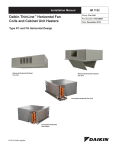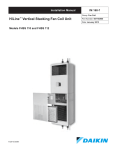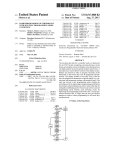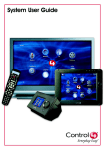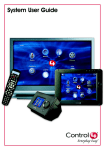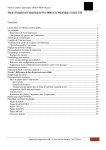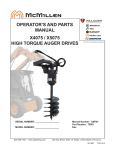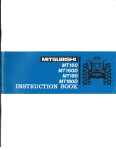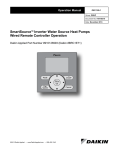Download Daikin MT 180 Specifications
Transcript
Installation and Maintenance Manual IM 1019 Group: Fan Coil Part Number: IM 1019 Date: October 2011 MT 180 Programmable Thermostat © 2011 Daikin Installation Instructions . . . . . . . . . . . . . . . . . . . . . . . 3 Applications and features . . . . . . . . . . . . . . . . . . . . . 3 Specifications . . . . . . . . . . . . . . . . . . . . . . . . . . . . . . 3 Thermostat Model and Part Number . . . . . . . . . . . . . 4 Optional Sensors/Kits . . . . . . . . . . . . . . . . . . . . . . . . 4 Installing, Mounting and Wiring the Thermostat . . . . 4 Operation . . . . . . . . . . . . . . . . . . . . . . . . . . . . . . . . . . . 6 Front Panel Reference . . . . . . . . . . . . . . . . . . . . . . . 6 Display Reference . . . . . . . . . . . . . . . . . . . . . . . . . . . 6 Saving Changes . . . . . . . . . . . . . . . . . . . . . . . . . . . . 7 Up/Down Arrow Button Operation . . . . . . . . . . . . . . . 7 System Button Operation . . . . . . . . . . . . . . . . . . . . . 8 Fan Button Operation . . . . . . . . . . . . . . . . . . . . . . . . 8 Program Button Operation . . . . . . . . . . . . . . . . . . . . 8 Function Overview . . . . . . . . . . . . . . . . . . . . . . . . 8 Setting the Clock & Day . . . . . . . . . . . . . . . . . . . . 9 Setting the Temperature Display . . . . . . . . . . . . . 9 Programming Time & Temperature Settings . . . . 9 Overriding the Program . . . . . . . . . . . . . . . . . . . . 10 System Check-out . . . . . . . . . . . . . . . . . . . . . . . . . . 11 Condensate Overflow Interrupt . . . . . . . . . . . . . . . . 11 Thermostat configuration/ Service Menu . . . . . . . . 11 Technical and Application Notes . . . . . . . . . . . . . . Fan Operation . . . . . . . . . . . . . . . . . . . . . . . . . . . . Standard Fan Operation . . . . . . . . . . . . . . . . . . Staged Fan Operation with Temperature Demand . . . . . . . . . . . . . . . . . . . . Fancoil Operation . . . . . . . . . . . . . . . . . . . . . . . . . . Pipe Sensor Operation . . . . . . . . . . . . . . . . . . . Purge Cycle Operation . . . . . . . . . . . . . . . . . . . HVACSetback Systems . . . . . . . . . . . . . . . . . . . . . Setback Operation - Remove JP3 . . . . . . . . . . . Door Switch Only Operation - Install JP3 . . . . . 12 12 12 12 12 12 12 13 13 13 Optional Occupancy Detection Equipment Operation . . . . . . . . . . . . . . . . . . . . . . . . Occupancy Operation (Install JP3) . . . . . . . . . . . . Operation From an Occupied Mode . . . . . . . . . Operation From an Unoccupied Mode . . . . . . . . SB200-001 Occupancy Sensor . . . . . . . . . . . . . . . Operation . . . . . . . . . . . . . . . . . . . . . . . . . . . . . . SD200-001 Occupancy Sensor . . . . . . . . . . . . . . . Operation . . . . . . . . . . . . . . . . . . . . . . . . . . . . . . SD200-002 Occupancy Sensor . . . . . . . . . . . . . . . Operation . . . . . . . . . . . . . . . . . . . . . . . . . . . . . . 14 14 14 14 14 14 15 15 15 15 Annex I . . . . . . . . . . . . . . . . . . . . . . . . . . . . . . . . . . . 16 Annex II . . . . . . . . . . . . . . . . . . . . . . . . . . . . . . . . . . . 17 2 Daikin IM 1019 Installation Instructions Installation Instructions Specifications WARNING • READ THESE INSTRUCTIONS CAREFULLY BEFORE ATTEMPTING TO INSTALL, OPERATE OR SERVICE THIS THERMOSTAT. • Failure to observe safety information and comply with instructions could result in PERSONAL INJURY, DEATH AND/OR PROPERTY DAMAGE. • To avoid electrical shock or damage to equipment, disconnect power before installing or servicing and use only wiring with insulation rated for full thermostat operating voltage. • Before installing this control, the Voltage Selection Switch must be placed in the correct position. See instructions. Table 1: MT180 Programmable Thermostat Specifications Temperature Set Point Range Differential Memory – Back-Up Mounting Physical Dimensions Agency Approvals Electrical Ratings 50 to 90°F / 10 to 32°C 1° EEPROM, No batteries required, Stores settings for unlimited time Installs on standard 4" x 4" device box with a 2" x 4" horizontal mud ring 4.4"H x 5.8"W x 1.1"D UL, UL Canada (see Ratings table) Figure 1: MT180 Programmable Thermostat Dimensions • To avoid potential fire and/or explosion do not use in potentially flammable or explosive atmospheres. • Retain these instructions for future reference. This product, when installed, will be part of an engineered system whose specifications and performance characteristics are not designed or controlled by PECO. You must review your application and national and local codes to assure that your installation will be functional and safe. CAUTION • Use copper wire only, insulate or wire nut all unused leads. • Care should be used to avoid electrostatic discharge to the T180 thermostat. • This unit has configuration jumpers. You may need to reconfigure this thermostat for your application Applications and features For 2 or 4 Pipe Fan Coil and On/Off Control Applications • 7 Day, 4 Event Programmability • System Selection: Off-Heat-Cool-Auto-Setback • 6 Outputs: 1H, 1C, Up to 3 Fan, OA Damper • Fan Control: 1-3 Speeds - Cycling (Auto) or Continuous (On) - Automatic Fan Speed Staging (TB180 models only) Connections for: • Fan Coil Pipe Sensor • Remote Temperature Probe • Occupancy Control • Door Switch or Setback • Condensate Overflow Daikin IM 1019 3 Installation Instructions Thermostat Model and Part Number Daikin offers two different 7-Day Programmable Digital Heating/Cooling Thermostat with constant fan or Fan cycled, On/Off Valve Control depending on the fan speed control used (See Table 2). . Table 2: Thermostat Model and Part Number Model Number Part Number Fan Speed Control TA180-001 TB180-001 910119110 910119111 3-speed fan control Staged fan control • Use copper wire only. Insulate or wire nut all unused leads. • Avoid electrostatic discharge to the thermostat. • Failure to do so can cause thermostat malfunction or permanently damage the thermostat. DANGER Hazardous voltage. Combined load current is not to exceed 20 amps. Mount only to a grounded metallic box. Low voltage wiring is Class 2. To avoid electrical shock or Damage to equipment, disconnect power before installing or servicing. Failure to follow these instructions will result in death or serious injury Optional Sensors/Kits In addition to the T180 thermostat, Daikin offers optional sensors for occupancy detection (page 14 and page 15) and 10K pipe sensor page 12) that can be ordered and used in conjunction with the thermostat. Use the associated kit number(s) provided in Table 3 when ordering. 1 Disconnect power before installing or servicing. 2 Run line voltage wiring (and low voltage wiring if applicable) into the field provided outlet box and mud ring (Figure 2). 3 Locate all connections within the mud ring/connection box and wire nut all unused wires. Table 3: Sensor Model and Kit Numbers Sensor Model Number Daikin Part Number SB200-001 SD200-001 SD200-002 10K Pipe Sensor Occupancy Detection Sensor 6677877311 6677877411 6677877511 107201601 4 Remove the thermostat cover assembly from its base to gain access to the circuit board (Figure 3). Figure 2: Mounting the Thermostat Installing, Mounting and Wiring the Thermostat The thermostat should be used indoors only. It should be mounted on an inner wall in a location with freely circulating air, and where it will be responsive to changes in room temperature. Avoid mounting near heat generating appliances (i.e. TV, heater, refrigerator), or in direct sunlight. The thermostat base mounts to a field provided 4" × 4" outlet box with a 2" × 4" horizontal mud ring. The thermostat cover assembly mounts to the thermostat base. . CAUTION Before applying power, the voltage selection switch must be in the appropriate position. Failure to select the correct voltage can cause thermostat malfunction or permanently damage the thermostat. Figure 3: Circuit Board CAUTION To use a remote sensor on units with local sensing capability, remove jumper JP1 to disable local sensing. Failure to remove JP1 can cause improper operation of the thermostat with a remote probe installed. CAUTION 4 Daikin IM 1019 Installation Instructions 5 On the circuit board, set the voltage selection switch Figure 4: Wiring Diagram (Figure 3) to the appropriate position prior to application of power. • 24V = 24 VAC • 110-277 V = 120, 240 or 277 VAC Note: The circuit board is shipped with the voltage selection switch in the 110-227 V position. For 24 VAC use, the switch must be in the 24 V position 6 The circuit board is also equipped with configuration jumpers (JP1, JP3, and JP4 in Figure 3). Depending on the application, it may be necessary to reconfigure the following jumpers: JP1 Jumper Selection – Remote Temperature Sensor Local Sensing – Install JP1 Remote Sensing – Remove JP1 – Accessory sensors are available in standard 60" lengths but can be extended to meet application requirements. JP3 Jumper Selection – HVAC Setback Systems The JP3 jumper allows the T180 to be configured for Setback, Occupancy Detection or Door Switch Only Occupancy Operations. For further descriptions of these conditions please see the Technical and Application Notes‚ page 12. Table 4: Jumper Activation JP4 Section • Setback Operation - Remove JP3 • Occupancy Detection - Install JP3 • Door Switch Only - Install JP3 JP4 Jumper Selection – 2 or 4 Pipe Operation Connection of a pipe sensor will change the operation of the outputs as shown in Table 4. (See Technical Notes for further information on Pipe Sensor Operation‚ page 12) • 2-Pipe Operation - Install JP4 - The thermostat will permanently disable the Secondary Output and disables system and fan invalid modes. • 4-Pipe Operation - Remove JP4 - Both the Main Output (COOL) and Secondary Output (HEAT) will be available. 7 Connect the color coded thermostat wires (Figure 4) to 2-Pipe JP4-ON 2-Pipe JP4-OFF Note: Pipe Sensor Water Temp Aqua Stat Cold Open Hot Cold Hot Closed Open Closed Main Output (Blue Wire) Secondary Output (Red wire) Cooling Only Heating Only Cooling Heating Only Disabled Disabled Heating Disabled *Fan will not cycle on for disabled modes. Table 5: Output Ratings Output Ratings RES PILOT AMPS DUTY 24 VAC NA NA NA 24 VA 120 VAC 5.8 34.8 6.0 125 VA 240 VAC 2.9 17.4 5.0 125 VA 277 VAC 2.4 14.4 4.2 125 VA Combined Load Current Not to Exceed 20 Amps Voltage FLA LRA HP NA ¼ ¼ ¼ the line voltage wires located in the mud ring/connection box and secure the connections with wire nuts. 8 Install the thermostat base to the mud ring/outlet box using two furnished mounting screws. Tighten the screws evenly but do not over tighten. Note: An output ratings chart (Table 5) is located on the inside of the base. 9 With the base now secured, verify that the circuit board is firmly snapped into the cover and is not dislodged. 10 Install the cover assembly to the base, pressing firmly to engage the cover locking snaps. Daikin IM 1019 5 Operation Operation Front Panel Reference The thermostat interface (Figure 5) contains buttons for use in navigating to accompanying menus/screens and for performing specific operations. These buttons and operations are described below. 1 Liquid Crystal Display with a blue backlight 2 UP ▲and DOWN ▼Buttons 1 System Mode Display Table 6: System Mode Display Overview Menu Description HEAT COOL Indicates the system is in heating mode Indicates the system is in cooling mode Indicates the system will automatically changeover between heating and cooling modes as the room temperature varies Turns off the entire system Indicates the heating or cooling system is operating in setback mode. Setback mode is an energy saving feature that can be either manually activated by the thermostat’s user, or automatically activated by an occupancy sensor or door switch AUTO OFF 3 SYSTEM Button 4 FAN Button 5 PROGRAM Button. SETBACK Figure 5: MT180 Programmable Thermostat Interface 2 Temperature Display Table 7: Temperature Display Overview Menu Default display During programming Description Digits display the current room temperature Digits are used to set the desired temperatures 3 Time and Day Display Table 8: Time and Day Display Overview Menu Default display During programming Display Reference Figure 6: MT180 Programmable Thermostat Display Reference CLOCK 24Hr AM / PM Description Digits indicate the current time, and day abbreviations indicate the current day Digits and days are used to program time periods Lights up during programming when the clock is being set Lights up during programming to indicate time will be displayed in 24-hour clock format Indicates 12-hour clock format 4 Programming Commands Table 9: Programming Commands Overview Menu SET COPY DFLT Description Enters thermostat into custom program mode which allows you to specify a unique times and temperatures for a particular day or group of days Simplifies programming by allowing you to copy all of an individual day’s settings to another day or group of day Restores the thermostat to the factory program 5 Time Period Indicators WAKE, DAY, EVE, and SLEEP are the names given to the four time periods per day. Each time period has its own unique setpoint temperatures as shown in Table 15. 6 Daikin IM 1019 Operation Saving Changes 6 Fan Operation Indicators Table 10: Fan Operation Indicators Overview Menu FAN ON AUTO HI M LO Description “FAN” will be always be lit in conjunction with “ON” or “AUTO” Indicates constant, continuous fan operation Indicates fan is only on with heating or cooling demand Indicates high speed fan; always lit in conjunction with “ON” or “AUTO” Indicates medium speed fan; always lit in conjunction with “ON” or “AUTO” Indicates low speed fan; always lit in conjunction with “ON” or “AUTO” 7 Program Override Commands Table 11: Program Override Commands Overview Menu HOLD HOLD HRS HOLD DAYS HOLD ON OFF Description Indicates thermostat is in manual operation. (Programmed settings are off, but not lost) During programming, lights up in conjunction with clock digits; allows program to be put on hold for up to 24 hours During programming, lights up in conjunction with the clock digits; allows program to be put on hold for up to 99 days Indicates thermostat is in permanent manual operation Turns off the hold and resumes programmed settings 8 Service Indicator The wrench symbol is displayed when there is a temperature sensor error or condensate overflow error. It indicates there is an open or a short connection to the sensor switch. When this occurs, the thermostat will disable all outputs and illuminate the wrench symbol. A service technician should be called to determine the cause of the error. Daikin IM 1019 As you navigate your thermostat, be aware of the thermostat’s save and exit protocol: • The thermostat automatically saves all the changes you make, as you make them. • When you are in the SYSTEM or FAN menus: – If you push a button that is not applicable to the current menu, all changes are saved and the thermostat goes to the menu associated with the button that was pushed. – If the thermostat is idle for five seconds, the thermostat times out, saves all changes, and returns to the thermostat’s default display. • When you are in the PROGRAM menu: – If you push a button that is not applicable to the current menu, nothing happens (your programming is not interrupted). – If the thermostat is idle for fifteen seconds, the thermostat times out, saves all changes, and returns to the thermostat’s default display. Up/Down Arrow Button Operation The ▲and ▼buttons function in two ways: • When you are in the default display, you can press ▲to increase, or ▼to decrease, the current temperature setpoint. This will override programmed temperature settings until the next programmed time period (Wake, Day, Evening, or Sleep). • When you are in the PROGRAM menu, you can press ▲to scroll up, or ▼to scroll down, through the menu, time, and temperature options. 7 Operation System Button Operation Fan Button Operation Pressing SYSTEM will light up the five system mode options described below. Press SYSTEM to scroll through the options. As you scroll, the current option will be blinking. To select the blinking option, wait for the five-second timeout, which saves your option and returns you to the thermostat’s default display. Pressing FAN will light up the six fan mode options described below. Press FAN to scroll through the options. As you scroll, the current option will be blinking. To select the blinking option, wait for the five-second timeout, which saves your option and returns you to the thermostat’s default display. Table 12: System Button Operation Overview Table 13: Fan Button Operation Overview Menu HEAT COOL AUTO OFF SET BACK Description The thermostat operates as a Heating Only thermostat The thermostat operates as a Cooling Only thermostat The thermostat automatically selects the appropriate Heat or Cool mode depending upon the setpoint (desired temperature) and zone temperature (actual temperature) Turns the system off by disabling all thermostat outputs Setback mode is an energy saving feature that minimizes the heating and cooling when the room is not occupied. Setback mode overrides the programmed time and temperature settings by telling the thermostat to instead use the setback setpoint for heating and cooling. The setback setpoint temperatures are factory default or installer-selected during installation. During setback mode, when a demand for heating or cooling exists, the fan will run at the lowest speed. • Automatic setback mode: If your thermostat is connected to an occupancy sensor or door switch, setback mode is automatically turned on and off by the sensor or door switch. • Manual setback mode: Select SETBACK in the SYSTEM menu. Setback temperature settings will remain in effect until you manually turn off setback mode. Selecting HEAT, COOL, or AUTO in the SYSTEM menu will turn off setback and resume your programmed time and temperature settings. Note: SETBACK appears on your menu only if the thermostat’s installer enabled this feature. Menu ON HI ON M ON LO AUTO HI AUTO M AUTO LO Program Button Operation Function Overview Pressing PROGRAM lights up five program mode options, described below. Press ▲or ▼buttons to scroll through the options. As you scroll, the current option will be blinking. To select the blinking option, press PROGRAM again and you will be taken to the menu associated with that option. Table 14: Program Button Operation Overview Menu Description CLOCK Sets the current time and day. Use this option to change the temperature display to Fahrenheit or Celsius. Your thermostat’s default temperature display setting is Fahrenheit. Use to specify the time and temperature programming for a particular day or group of days. Also allows you to reset the thermostat to the factory default ENERGY STAR program. Simplifies programming by allowing you to copy a particular day’s program to another day or group of days. Puts the thermostat in manual operation for a permanent or temporary time period. Overrides your programmed settings, but does not lose them. °F / °C SET COPY HOLD 8 Description High speed fan is on continuously, even if no demand for heating or cooling exists Medium speed fan is on continuously, even if no demand for heating or cooling exists Low speed fan is on continuously, even if no demand for heating or cooling exists High speed fan cycles with active demand for heating and cooling Medium speed fan cycles with active demand for heating and cooling Low speed fan cycles with active demand for heating and cooling Daikin IM 1019 Operation Setting the Clock & Day 1 Press PROGRAM once. 2 Press ▲or ▼to scroll until “CLOCK” is blinking. To select, press PROGRAM once. 3 Press ▲or ▼to scroll through “24Hr”, “AM”, “PM” options. “24Hr” sets your thermostat to a 24-hour clock. “AM” and “PM” sets your thermostat to a 12-hour clock. To select your preference, press PROGRAM once. 4 Press ▲or ▼to scroll to the current hour. To select, press PROGRAM once. 5 Press ▲or ▼to scroll to the current minute. To select, If the factory program meets your needs, simply follow the “Setting the Clock & Day” instructions and you’re done. If you want to change the preprogrammed times and/or temperatures, follow the instructions under “Custom Program”. Custom Program Begin by planning your program. Use the “Custom Program Worksheet” to plan your program time periods and temperatures you want during each period. You must program four periods for each day. Fill in the complete table, as it will serve as a record of your programs, then follow this procedure: 1 Press PROGRAM once. press PROGRAM once. 6 Press ▲or ▼to scroll to the current day. To select, press 2 Press ▲or ▼to scroll until “SET” is blinking. To select, press PROGRAM once. PROGRAM once. Your selections have been saved and you have exited program mode. Your thermostat is ready to function with the factory preprogrammed ENERGY STAR® program. If you want to change the program for your particular needs, follow the instructions in the “Programming Your Thermostat” section. Setting the Temperature Display 1 Press PROGRAM once. 2 Press ▲or ▼to scroll until “°F °C” is blinking. To select, press PROGRAM once. 3 Both “°F” and “°C” will be lit, but only one will be blinking. Press ▲or ▼to scroll so that the preferred option is blinking. To select, press PROGRAM once. Your selection has been saved and you have exited program mode. Programming Time & Temperature Settings Your thermostat’s programming feature allows you to divide up a 24-hour day into four time periods (referred to as “Wake”, “Day”, “Evening”, and “Sleep”), and give each time period its own setpoint temperatures. Your “Heat Setpoint temperature” tells your heating system the room temperature to maintain during cold weather. The “Cool Setpoint Temperature” tells your cooling system the room temperature to maintain during hot weather. Factory Program: Your thermostat comes from the factory preprogrammed with all seven days of the week set to the times and temperatures shown in Table 15. 3 Press ▲or ▼to scroll to the day or group of days you want to program. To select your preference, press PROGRAM once. Day / Group of Days options are: • To program each day individually, the abbreviations are: “M” is Monday, “TU” is Tuesday, “W” is Wednesday, “TH” is Thursday, “F” is Friday, “SA” is Saturday, and “SU” is Sunday. • “MTUWTHFSASU” allows you to give all 7 days of the week the identical heating & cooling program. • “MTUWTHF” allows you to give all 5 weekdays the identical heating & cooling program. • “SASU” allows you to give both weekend days the identical heating & cooling program. • “DFLT” restores all seven days of the week to the original factory preprogrammed ENERGY STAR program. 4 Press ▲ or ▼to scroll through the four time periods. To select your preference, press PROGRAM once. 5 Press ▲ or ▼to scroll to the desired starting hour. To select, press PROGRAM once. 6 Press ▲ or ▼to scroll to the desired starting minute. To select, press PROGRAM once. 7 Press ▲ or ▼to scroll to the desired HEAT setpoint temperature. To select, press PROGRAM once. 8 Press ▲ or ▼to scroll to the desired COOL setpoint temperature. To select, press PROGRAM once. Table 15: Factory Set-Up of Time & Temperature Settings Time Period Start Time Heat Setpoint Temperature Cool Setpoint Temperature Wake Day Evening Sleep 6:00 am 8:00 am 6:00 pm 10:00 pm 70° F (21.0° C) 62° F (16.5° C) 70° F (21.0° C) 62° F (16.5° C) 78° F (25.5° C) 85° F (29.5° C) 78° F (25.5° C) 72° F (22.0° C) Daikin IM 1019 9 Operation Copy Feature 1 Press PROGRAM once. 2 Press ▲or ▼to scroll until “COPY” is blinking. To select, press PROGRAM once. 3 Press ▲ or ▼to scroll to the individual day you want to copy from. “DFLT” (the default Factory Program) is also a copy option. To select your preference, press PROGRAM once. 4 Press ▲ or ▼to scroll to the day or group of days you want to copy to. To select, press PROGRAM once. Overriding the Program Your thermostat’s HOLD feature allows you to put the thermostat in manual operation for either a specified or indefinite length of time. HOLD will override your programmed settings, but does not lose them. Setting up a Temporary Hold You may set up a temporary hold by hours and/or days. 1 Press PROGRAM once. 2 Press ▲or ▼to scroll until “HOLD” is blinking. To select, press PROGRAM once. Your selection has been saved and you have exited program mode. Time & Temperature Programming Example In this example, the thermostat user wants to program the weekend with a different schedule from the Factory Program. The user wants the Saturday and Sunday program to be identical. 1 Press PROGRAM once. 2 Press ▲or ▼to scroll until “SET” is blinking. To select, press PROGRAM once. 3 Press ▲or ▼to scroll until “SASU” is blinking. To select, press PROGRAM once. 4 Press ▲or ▼to scroll until “WAKE” is blinking. To select, press PROGRAM once. 5 Press ▲or ▼to scroll hours to “8: ”. To select, press 3 3.Press ▲or ▼to scroll through options. “DAYS” allows you to specify 0-99 days hold; “HRS” allows you to specify 0-24 hours hold. To select your preference, press PROGRAM once. 4 Press ▲or ▼to scroll to the desired length of time. To select, press PROGRAM once. The thermostat is now on hold for the time period you selected, unless you decide to turn it off earlier. (See Turning off a Hold.) Setting up a Permanent Hold 1 Press PROGRAM once. 2 Press ▲or ▼to scroll until “HOLD” is blinking. To select, press PROGRAM once. 3 Press ▲or ▼to scroll to “ON”. To select, press PROGRAM once. PROGRAM once. 6 Press ▲or ▼to scroll minutes to “ :30”. To select, press PROGRAM once. 7 User wants to keep same HEAT setpoint temperature. To keep unchanged, press PROGRAM once. 8 User wants to keep same COOL setpoint temperature. To keep unchanged, press PROGRAM once. Now you’re done setting up the Wake period, and ready to set up the other three time periods for Saturday and Sunday: The thermostat is now on hold until you manually turn off the hold. (See Turning off a Hold.) Turning off a Hold 1 Press PROGRAM once. 2 Press ▲or ▼to scroll until “HOLD” is blinking. To select, press PROGRAM once. 3 Press ▲or ▼to scroll to “OFF”. To select, press PROGRAM once. • Program the Day period for SASU by repeating steps 1 through 8, but in Step 4, select “DAY”. The thermostat will now resume your programmed time and temperature settings. • Program the Evening period for SASU by repeating steps 1 through 8, but in Step 4, select “EVE”. For an easy planning refer to the Custom Program Worksheet (Annex I‚ page 16). • Program the Sleep period for SASU by repeating steps 1 through 8, but in Step 4, select “SLEEP”. Now you’re done setting up all four time periods for SASU. 10 Daikin IM 1019 Operation System Check-out To verify thermostat operation after mounting and wiring it, perform the following: Figure 8: Local sensor installation 1 Energize the system. 2 Set fan to ON. Select each fan speed (TA180 Models) to verify operation. 3 Set the System button to AUTO, or available selection. 4 Using the UP arrow, adjust temperature more than 5°F above the room temperature to cycle on heating. 5 Using the DOWN arrow adjust the temperature to 5°F below room temperature to cycle on cooling. Note: If the thermostat is set to utilize a time-based purge cycle (Service menu 16), the thermostat will conduct a 3-min purge on initial start-up if a pipe sensor is connected. Condensate Overflow Interrupt The remote probe input can be used with a condensate overflow interrupt switch (CO), either in conjunction with a remote probe (normally closed CO switch) or with local sensing (normally open CO switch). When the condensate switch activates, the T180 will display the service wrench and disable all outputs. Thermostat configuration/ Service Menu To enter the Service Menu press the UP and DOWN arrows simultaneously for five (5) seconds. The current display icon will be turned off. Service menu number 1 will appear. Push the SYSTEM button to move to the next Service Menu number. The UP and DOWN arrow keys will scroll through your range of options for each feature. All changes to the Service Menu are automatically saved when the system times out. Please refer to the service menu table (Annex II‚ page 17). Figure 7: Remote probe installation Daikin IM 1019 11 Technical and Application Notes Technical and Application Notes Fan Operation Fancoil Operation The thermostat may be factory configured for standard or staged fan operation. Fancoil operation is either a 2-pipe or 4-pipe configuration which is determined by jumper selection JP4 (see Installing, Mounting and Wiring the Thermostat‚ page 4). Standard Fan Operation Table 16: Standard Fan Operation Overview Menu FAN ON FAN AUTO FAN SPEED Description Fan is on continuously and is not dependant on a heat or cool demand Fan cycles on with a heat or cool temperature demand and cycles off with the heat or cool output High, medium, or low is selected by the user Single setpoint represented in Figure 9. Programming mode includes multiple setpoints. Staged Fan Operation with Temperature Demand Table 17: Staged Fan Operation with Temperature Demand Overview Menu FAN ON FAN AUTO FAN SPEED Description Fan stages from high to medium to low and stays continuously on in the lowest available speed Fan stages from high to medium to low and cycles off at set point selected by the thermostat program Single setpoint represented in Figure 10. Programming mode includes multiple setpoints. Figure 9: Standard Fan Operation Pipe Sensor Operation A pipe sensor can be connected when the thermostat is configured for either 2-pipe or 4-pipe fan coil operation (see JP4 jumper configuration). The Pipe sensor is used to determine the water temperature in the Main Coil. The Pipe Sensor should be mounted on the Main Coil supply and wrapped with insulating material. Pipe Sensor Input: 10K Remote Probe or a standard On-Off Aqua-stat can be used for summer/winter changeover. ON (closed) is winter heating mode and OFF (open) is summer cooling mode. Purge Cycle Operation With a pipe sensor connected, this thermostat will initiate a purge cycle if the sensed water temperature is ambiguous (not adequately hot or cold). The purge cycle algorithm can be either temperature or time based, depending on the configuration of Service Menu 16. Temperature-Based Purge • When an Ambiguous mode is detected and a demand exists, a 3 minute purge timer begins and the Main Output is opened. • After the 3 minute purge cycle, the thermostat checks again to see if the water temperature is more than 15°F from set point, or above 80°F or below 60°F. • If Winter or Summer mode is determined, normal HVAC operation occurs. If still ambiguous, the thermostat checks to see if the COIL temperature is below 60°F or above 80°. Coil < 60°F = Summer Mode. Coil > 80°F = Winter mode. • Purge Cycle is repeated until a non-ambiguous condition is sensed. Figure 10: Staged Fan Operation 12 Note: If at any time the demand goes away, the thermostat will abort the purge cycle. Daikin IM 1019 Technical and Application Notes Time-Based Purge (Default) 1 The time-based purge cycle will start a 3-min purge cycle and enable the Main Output if any of the following conditions occur: transition from OFF to AUTO mode, Reset event, power cycle, and/or 1-hour timer expires. 2 After the 3 min purge cycle, a pipe sensor reading says: Pipe is 15°F+ below the zone temp = Summer mode Pipe is 15°F+ above the zone temp = Winter mode Pipe is within 15°F of zone temp = still Ambiguous 3 If a Winter or Summer mode is determined, the appropriate heating/cooling occurs. The thermostat will purge and check pipe temperatures again after 1-hour. • If step 2 is still ambiguous, all thermostat outputs are disabled for 1 hour. • After 1 hour, the purge cycle resumes at step 1. Daikin IM 1019 HVACSetback Systems Setback Operation - Remove JP3 This is a low level input that is normally open. When switch is closed, the T180 heating and cooling setback limits are used as temperature control points. Fan operation in setback is cycled with demand. Pressing any button will override setback for 1 hour. Setback will override any user setting unless control is turned to OFF. Intelligent Occupancy Sensors like the SD200-001 and SD200-002 can be used with this input to set the HVAC system to control at setback limits. Door Switch Only Operation - Install JP3 A stand alone door or window switch can be connected to the T180 to disable the HVAC system (outputs) if a door or window is left open for more than 2 minutes. A one-time ten minute override can be initiated by pressing any thermostat key pad. 13 Optional Occupancy Detection Equipment Operation Optional Occupancy Detection Equipment Operation The T180 thermostat can be used with optional S200 series occupancy detection equipment. Purchasing and installing this equipment to compliment the thermostat adds energy savings by setting back HVAC operation during occupied and unoccupied times. The sensor switch is open in occupied mode and closed in unoccupied mode. An optional door and/or window switch (Figure 11) is open when the door/window is open and is closed when the door/window is closed. Occupancy Operation (Install JP3) JP3 to allow occupancy input. The T180 can be used with PECO S200 series occupancy detection equipment. The occupancy and switch inputs are designed to connect to the SB200 slave sensor and SE200 door switch. The Occupancy Sensor is a low-level switch that is open when there is occupancy and closed when unoccupied. The Door Switch is a low-level switch that is open when the door is open and closed when the door is closed. This system requires both an Occupancy Sensor and a Door Switch. Operation From an Occupied Mode The T180 operates normally and looks for a door close. A door close signal initiates occupancy status detection. If occupancy is detected, the T180 will maintain normal HVAC control. It then waits for a door open signal before determining occupancy again. If no occupancy signal is detected within 2 minutes, the T180 changes to unoccupied mode and controls at setback temperature values. Operation From an Unoccupied Mode In an Unoccupied State, the T180 sets heating and cooling set points to setback values, as determined in the service menu. In this mode, the fan is automatically set to cycle with demand. The T180 will continually monitor the room for occupancy. Any occupancy detection, including door open, will set the operation to occupied mode. In either mode, if the door is left open for more than 2 minutes the T180 will disable the HVAC system. A one-time ten minutes override can be initiated by pressing any thermostat keypad. Note: To use this configuration, a jumper must be installed to Note: An optional door and/or window switch (Figure 11) can be added for use with the SB200-001 sensor. Operation In an occupied mode, the thermostat operates normally and looks for a door open signal. When the door opens, the thermostat waits for a door close signal. If the door is open for more than two minutes, the thermostat turns the HVAC system outputs to OFF. During this two minute period, if any button is pressed on the keypad, the time delay is extended to ten minutes. The time delay can only be extended once. Once the HVAC outputs transition to OFF, a door closure is required to re-enable the outputs. When the door closes, the thermostat starts a two minute timer and tries to detect occupancy. If the timer expires and no occupancy is detected, the thermostat transitions to an unoccupied state. If occupancy is detected while the timer is running, the thermostat will remain in the occupied mode. In an unoccupied mode, the thermostat sets heating and cooling set points to setback values as determined by factory or user settings. The fan is automatically set to cycle with demand. The thermostat continually monitors the occupancy sensor and will enter into occupied mode if occupancy is detected. If the installation is only using a door/window switch, the thermostat will disable the HVAC outputs if this output is open for longer than two minutes. To enable door/window switch only operation, install a jumper to JP3 (see Installing, Mounting and Wiring the Thermostat‚ page 4) and the occupancy input must be shorted to circuit common. Figure 11: Optional equipment configuration #1 Optional detection equipment configurations and operation are described below. SB200-001 Occupancy Sensor The SB200-001 occupancy sensor (Figure 11) serves as an occupancy sensor for automatic control of a guest room HVAC system. It incorporates an innovative dual delay processor which allows the sensor to verify the nature of occupancies, and is capable of eliminating unnecessary actuations of the HVAC device due to unintentional passages or short time occupancies. The sensor may also serve as a slave sensor (Figure 12, page 15). 14 Daikin IM 1019 Optional Occupancy Detection Equipment Operation SD200-001 Occupancy Sensor SD200-002 Occupancy Sensor The SD200-001 occupancy sensor (Figure 12) serves as a master sensor for a guest room HVAC management system. The sensor provides HVAC operation according to occupancy status, as well as door/window switch monitoring, selectable high/low temperature setback, form-C output, slave sensor connectivity, and a five minute door open HVAC shut-off. The SD200-002 occupancy sensor serves as a stand alone master sensor for a guest room HVAC management system. Note: To use this configuration, the jumper to JP3 is removed to allow setback input. Note: An optional door and/or window switch (Figure 12) and slave sensor can be added for use with the SD200-001 sensor. The sensor provides HVAC operation according to occupancy status, as well as selectable high/low temperature setback, form-C output, and a five minute door open HVAC shut-off. This system provides basic room setback and is ideal for control of HVAC in commercial spaces. Note: Note – To use this configuration, the jumper to JP3 is removed to allow setback input. Operation Operation In an occupied mode, the SD200-001 occupancy sensor (Figure 12) and door switch use advanced microprocessor logic to determine occupancy. A door open signal will initiate occupancy status detection. If the sensor determines that a room is occupied, it will allow normal HVAC control. The sensor will wait for another door open signal before determining occupancy again. With each occupancy detection, an OFF delay is started and can be set to delay for up to 30 minutes (Figure 13). Figure 13: Optional equipment configuration #3 In an unoccupied mode, the sensor continually monitors the room. Any occupancy detection will set the operation to occupied mode. Figure 12: Optional equipment configuration #2 Daikin IM 1019 15 Annex I Annex I Table 18: Custom Program Worksheet Day Time Period Start Time Heat Setpoint Temperature Cool Setpoint Temperature Wake Day Monday Evening Sleep Wake Day Tuesday Evening Sleep Wake Day Wednesday Evening Sleep Wake Day Thursday Evening Sleep Wake Day Friday Evening Sleep Wake Day Saturday Evening Sleep Wake Day Sunday Evening Sleep 16 Daikin IM 1019 Annex II Annex II Table 19: Service Menu Table Menu Feature 1 F° or C° 3 Fan Off Delay 4 Range Low 5 Range High Range Description / Comments 0- Celsius 1- Fahrenheit (Default) Determines temperature displays in Fahrenheit or Celsius 0-99 Seconds (0- Default) The amount of time (in seconds) the lowest available fan speed will run after the thermostat outputs are disabled. 50-90°F, 10-32°C (50°F- Default) 50-90°F, 10-32°C (90°F- Default) 0- OFF 82°F, 11-27°C (55°F- Default) 0- OFF 50-90°F, 11-32°C (90°F- Default) The lowest selectable temperature setpoint value. The highest selectable temperature setpoint value. 50- The temperature setpoint value you want the thermostat to Heat to when the T180 is in the Setback mode. The temperature setpoint value you want the thermostat to Cool to when the T180 is in the Setback mode. Zone Temperature offset adjusts the sensed Zone Temperature displayed, allowing calibration in the field. 6 Setback Low 7 Setback High 8 Zone Temp Offset 9 Keypad Lockout 10 Fan Mode 11 Fan Speeds 12 System Mode 13 Controlled Off or Off Override 0- Disable (Default) 1- Enable 14 Front Panel Setback Control 0- Disable (Default) 1- Enable 15 Cycled Outside Air Damper 0- Cycles (Default) 1- Continuous 16 Temperature Based Purge Cycle 0- Time Based (Default) 1- Temperature Based Determines if the Purge Cycle will be Temperature or Time Based. 17 Minimum Dead Band Adjustment 3°F (Default) 3-10°F, 1.5-5°C A changeover deadband value prevents short cycling between Heating and Cooling modes. The value is adjustable to meet various HVAC system requirements. 18 Factory Default Reset 25 Pre-Occupancy Purge 30 32 Cycles Per Hour (CPH) Cooling Cycles Per Hour (CPH) Heating +/- 9°F or +/- 4.5°C (0°F- Default) 0- No keypad lockout (Default) 1- Disables System/Fan/Program 2- Disables all buttons 1- ON 2- Auto 3- ON or Auto (Default) 1- High 2- Low, High 3- Low, Med, High (Default) OFF, Auto OFF, Heat, Cool, Auto (Default) OFF, Heat, Cool Heat, Cool, Auto 0- Disable (Default) 1- Enable 0 Hours (Default) 0-3 Hours 3 CPH (Default) 0-6 CPH 5 CPH (Default) 0-12 CPH 5°F/Hr (Default) 0-18°F/Hr 0-10°C/Hr 5°F/Hr (Default) 0-18°F/Hr 0-10°C/Hr 4 Minutes (Default) 1-10 Minutes 0- Disable (Default) 1- Enable 5 Minutes (Default) 1-60 Minutes 25 Minutes (Default) 0-60 Minutes 35 Heat Recovery Rate 36 Cool Recovery Rate 40 Minimum Off Time 45 Intermittent Fan 46 Intermittent Fan-On Time 47 Intermittent Fan-Off Time 71 Revision 80 System Test Main Output (Cool) 0- Disable (Default) 1- Enable 81 System Test Main Output (Heat) 0- Disable (Default) 1- Enable 82 System Test Fan Output Daikin IM 1019 This function blocks access to certain features of the device. The Service Menu is still available if the keypad lockout is enabled. ON- Fan is always on, regardless of demand. Auto- Fan is only on with heating or cooling demand. ON or Auto- User can choose either selection. Speeds which are selectable by the user. Sets the system modes the occupant is able to select. When enabled, the unit will control to the Setback setpoints. This function will also override the user mode setting of OFF if the room temperature is equal to or above the Cool Setback setpoint or equal to or below the Heat Setback setpoint. When enabled, Setback is shown as an available system mode selection. If Setback mode is selected, the thermostat will control to the current Setback Heat and Setback Cool setpoints. The Outside Air output will cycle with heat or cool demand if Cycles mode is chosen. The Outside Air output is active anytime the thermostat is out of the OFF mode when Continuous mode is chosen. When in Setback the Outside Air output will turn off. Toggles between OFF and DFLT. When factory default is desired, select DFLT. Energizes Fan Low for selected number of hours (0-3) prior to events Wake (Occupied 1) and Day (Occupied 2) Defines the number of cycles per hour for cooling. A selection of 0 disables cycling. Defines the number of cycles per hour for heating. A selection of 0 disables cycling. Defines the rate in which the device achieves the comfort setpoint. 0 disables ramp recovery. Defines the rate in which the device achieves the comfort setpoint. 0 disables ramp recovery. Sets the minimum off time for both heat and cool output If enable is selected, the intermittent fan will operate during setback operation. (Default values will be used unless menu 46 and 47 are adjusted.) Defines the duration in which fan low will be on. Fan On will be activated after Fan Off time has passed. Defines the duration in which fan low will be off. Fan Off will be activated after Fan On time has passed. A selection of 0 will result in continuous Fan. Upon menu selection, the firmware and configuration revision will be displayed. 0- Disable (Default) 1- Enable Fan Low Output 2- Enable Fan Medium Output 3- Enable Fan High Output If enable is selected, it will activate the main output (cool output) for 10 minutes. Fan High will automatically turn on. If a different menu is selected the output will be disabled. If enable is selected, it will activate the secondary output (heat output) for 10 minutes. Fan High will automatically turn on. If a different menu is selected the output will be disabled. If enable is selected, it will activate the fan output for 10 minutes. If a different menu or a different fan speed is selected the output will be disabled. 17 Daikin Training and Development Now that you have made an investment in modern, efficient Daikin equipment, its care should be a high priority. For training information on all Daikin HVAC products, please visit us at www.DaikinApplied.com and click on training, or call 540-248-9646 and ask for the Training Department. Warranty All Daikin equipment is sold pursuant to its standard terms and conditions of sale, including Limited Product Warranty. Consult your local Daikin Representative for warranty details. Refer to Form 933-430285Y. To find your local Daikin Representative, go to www.DaikinApplied.com. This document contains the most current product information as of this printing. For the most up-to-date product information, please go to www.DaikinApplied.com. Daikin Applied 800.432.1342 www.DaikinApplied.com © 2011 Daikin 10/11


















